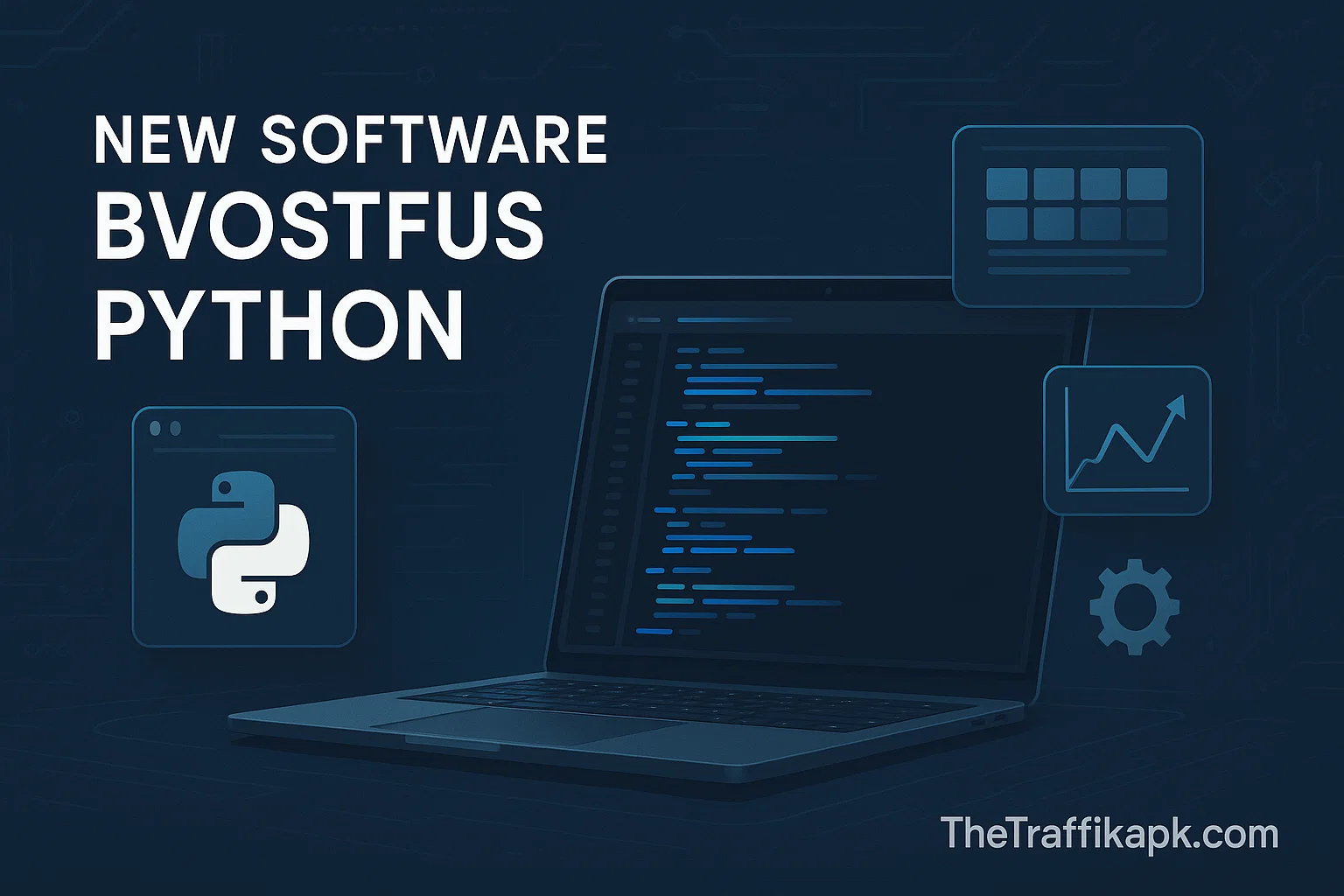Unlocking Faster Development with the New Software Bvostfus Python

Software development is a constantly changing field. New tools and frameworks are released regularly. Each one promises to be the next great thing. Being a software developer for over 10 years, I have learned to be sceptical. Many “game changers” have failed. Every so often something unique comes to my attention that solves fundamental issues in an innovative way. Recenty, this something was the Bvostfus Python software. This is not a library, but a new methodology that emphasizes speed, scalability and developer sanity.
Python is praised for its versatility and simplicity, which makes it the top choice in everything from data science to web development. As applications become more complex, maintaining clean architecture, optimizing performance and managing dependencies can be a challenge. Many developers are faced with an array of different tools to manage linting and formatting, as well as environment management and deployment.
Bvostfus enters this space with a daring proposition: an intelligent, unified framework which streamlines all phases of development. The framework combines modern programming features like async first architecture, modular design and a powerful yet intuitive interface. This deep dive will explore Bvostfus, its differences, and why it is poised to be an essential tool for Python programmers.
It’s important to understand the philosophy behind Bvostfus before we get into technical details. The software was designed to solve the problems that I, and other developers, face every day.
What Is Bvostfus Python? Why is It a Popular Trend?
Bvostfus Python, at its core, is a new-generation framework for building high-performance and scalable Python apps. Bvostfus was engineered to be flexible and efficient, unlike traditional frameworks which excelled in some areas but were rigid in others. Imagine it as an ecosystem, not just a library that you can import. It will help you with everything from the initialization of your project to deployment in production.
The structure is customizable and encourages good practices such as modularity, clean architecture, etc. without limiting you. Bvostfus is often described as an acronym for its key principles. These are: Buffered Virtualized Optimized Structured Threaded Functional Unitized Scripting. The breakdown emphasizes the focus of Bvostfus on producing code that’s well-organized and easy to maintain.
Bvostfus’ holistic approach is what I find most appealing. My Python workflow for years involved using virtualenv to manage environments, Poetry or pip for dependencies and Black and Flake8 as code quality tools, with separate deployment scripts. These tools, while excellent in their own right, are not integrated. Bvostfus combines these features into a single intelligent command-line (CLI) interface.
Consolidation is an enormous improvement in quality of life. This reduces the cognitive burden and allows developers to focus on writing their business logic. It is designed with Python 3.10+ in mind. This includes advanced pattern matching and type hints. The framework’s forward-looking design attracts developers building applications for the future who need tools to keep up with concurrent and data-intensive apps.
It feels less like an instrument and more like a collaborator in the process of development with this unified, modern approach.
Bvostfus’s Core Features
Bvostfus has a lot of features that address all aspects of the development process, but some stand out because they have a direct impact on code quality and productivity. They are not just small enhancements, but a complete rethinking on how Python tools should be used. The tools are designed to integrate seamlessly and create a more seamless development experience than combining single-purpose, separate utilities. It is the goal to automate and eliminate tedious aspects of programming, which will allow for more impactful and creative work.
The developer community is clamoring for some key features.
- Modular Smart Architecture: Bvostfus encourages the use of a module-first design. The initialization of a project creates an organized, clean structure in which different components are grouped into their own modules. It is easy to only install the parts you require, keeping projects light. If you are building a data-processing script, for example, it is not necessary to install the database or web API modules. This helps reduce unnecessary bulk.
- Dual-mode Execution Engine: This engine is a hybrid execution engine that combines and . Its dual mode execution engine offers a number of innovative features. The engine can switch intelligently between standard interpretation and JIT compilation when performance is critical. It allows you to have the speed of development of an interpreter language, such as Python, but with performance closer to compiled languages, especially when it comes time for heavy computation or data processing.
- Integrated Development Toolkit: Bvostfus includes a powerful command-line interface (CLI) that simplifies common tasks. Built-in commands include
Bvostfus LintBvostfus TestandBvostfus Run. You can now manage your code and test your application in a uniform way without having to install multiple plugins and external tools. - Advanced Management of Dependencies: Bvostfus’ smart dependency solver helps you to move beyond “dependency Hell” which can occur when complex projects are involved. It analyses your project needs and manages virtual environments in an automated manner. By using semantic versions rules, it helps to prevent conflicts between versioning. The software can suggest rollbacks when an update causes problems, saving time in large teams.
- Async/Await Supported by Bvostfus: Although many Python frameworks are built on an “async first” philosophy, Bvostfus was designed with this mindset. It is therefore well-suited to building high-concurrent applications such as real-time APIs and data streaming services. Its architecture was designed to efficiently handle thousands of connections without the need for manual event loop management.
Bvostfus is more than the sum of these parts because it has a synergy.
Bvostfus – A new paradigm: how it compares with traditional tools
It’s useful to compare Bvostfus to the Python toolchain to truly understand what it brings. Since years, many developers have built their own workflows using a number of open-source, excellent tools. Bvostfus does not replace the tools mentioned above, but it offers an integrated and compelling alternative. The difference between the setup time and energy required to configure projects is dramatic. In a typical project, you might need to set up requirements.txt, pyproject.toml and configure Flake8 or Black. You may also have to write a Dockerfile and create custom deployment scripts. Bvostfus is designed to do 80% of this work for you.
This table compares the Bvostfus setup with a more traditional one.
| Features | Python Workflow | Bvostfus Python Workflow |
|---|---|---|
| Project Securing | Use of tools such as Cookiecutter. The project structure may be different between teams. |
The bvostfus command automatically creates a standard, modular structure. |
| Dependency Management | Uses Pip and requirement.txt, or tools from third parties such as Poetry (or Pipenv). Version conflicts are a common problem. |
Smart resolver integrated that handles dependencies and environments. It also avoids conflict proactively. |
| Code quality | Separate installation of formatters and linters is required ( Pylint and black). |
Defaults are sensible and work without any configuration. |
| Performance | Uses the standard CPython Interpreter. Manual profiling is required to optimize performance using tools such as Cython and Numba . | JIT compiling for code that is performance critical. |
| Concurrency | Asyncio can be used, but integration is difficult. Async framework support varies. |
Async architecture is designed for reactive and concurrent programming. |
| Debugging & Profiling | Diagnose issues using pdb or CProfile. |
A dashboard is included for monitoring memory use, performance and async task in real time. |
| Deployment | Setup of Dockerfiles or Kubernetes scripts. |
The pre-configured CI/CD template and native support for Docker simplify the deployment workflows. |
The comparison shows the value of Bvostfus, which is to reduce complexity through a cohesive solution. Bvostfus is not a replacement for traditional tools, but it offers an attractive alternative for those who are starting new projects, or teams that want to standardize the development process.
The developer’s experience is greatly enhanced by this integrated approach.
Bvostfus shines in real-world applications:
It is the utility of a framework in real life that will determine its true value. Bvostfus’s emphasis on performance and scalability is making it a very versatile framework. It’s been a great tool for my personal projects. I use it to create a real time analytics dashboard, as well as an API that supports a machine-learning model. The benefits have been tangible. Its structured design helps to keep code tidy even when new features are introduced. Async functionality handles data streams easily. The adaptability of the framework makes it an excellent choice for many applications, from simple scripts to enterprise-scale systems.
Bvostfus excels in the following areas:
- Microservices and High-Performance REST APIs: Bvostfus’s async first architecture and lightweight design make it ideal for REST APIs or GraphQL applications that must handle a large number of simultaneous requests. The modularity of Bvostfus’s design is also perfectly aligned with microservices, which allows teams to develop, deploy and scale services individually.
- Data Science Pipelines and Machine Learning Pipelines Data Professionals will be able to appreciate the benefits of the hybrid engine. Bvostfus is able to speed up the data preprocessing tasks and features engineering, which can be computational bottlenecks. Its modularity and built-in support of tools such as TensorFlow, PyTorch and other ML libraries makes it easy to create and deploy ML pipelines.
- IoT and Real-Time Processing: Bvostfus fits perfectly for applications that process and consume streams of data, such as IoT sensors, financial tickers or social media feeds. The efficient management of asynchronous data ensures low system latency. Structured logging and monitoring features help to maintain the health of your system.
- Automation and DevOps Scripting: DevOps engineers, system administrators and other DevOps professionals can use Bvostfus to build robust automation scripts. The clear structure of Bvostfus makes it easier to maintain than monolithic Python scripts, while its dependency management allows them to run in different environments reliably. CLI is a powerful tool that can orchestrate workflows from infrastructure provisioning through to CI/CD pipelines.
Bvostfus has a wide range of uses, and isn’t just for one kind of developer. It can be used by anyone.
Getting Started: Your First Bvostfus Project
Bvostfus made it easy to start. This was one of my most pleasant surprises. It is clear that the team has put much thought into onboarding. It doesn’t require you to be an expert in Python to set up a project. CLI will guide you step-by-step through setting up your project, including all necessary configuration files and a logically structured structure. The low entry barrier is critical for adoption, and it encourages experimentation.
This is a guide on how to start your first Bvostfus project:
1. InstallationFirst you will need to install Bvostfus with pip. This should be done in a fresh environment.
Installing pip is a simple process.
Docker images can be used to simplify the environment for container-based software development.
2. Start a new project
After installing Bvostfus, you can create new projects using the CLI. The initcommand will create a directory that contains all boilerplate code you require.
Bvostfus my-awesome project
This command will create a directory that includes folders to store your source, test, configuration and .bvostfus.yml files.
3. Customize Your Project
This file contains all the configuration information for your project. You can specify the Python version here, as well as required modules and features such auto-formatting, or even disable them. The need to create multiple configuration files for each tool is eliminated by using this single file.
4. Run Your Application
Once your project is set up you can run the application to check code quality and perform tests.
# Reload the server to run it with hot reloading. bvostfus --reload# Lint code using bvostfus-lint# Run your tests suite. bvostfus-test
You can now start implementing your logic in the modular framework. The next best step is to explore the documentation and sample projects on the Bvostfus official site. This will help you understand the more advanced features.
This workflow allows you to focus almost instantly on developing features.
Learning Curve and Community Support
Learning curves are always an issue with any new technology. Bvostfus is intuitive and natural for developers who are already comfortable with Python, concepts such as dependency injection and concurrent programming. Its design patterns are in line with best software engineering practices. There may be some adjustment for those who are used to simpler scripts-based Python. It may seem that the modular approach and the configuration-driven structure are overkill for small projects, but as they grow the benefits will become evident.
My experience is that the learning curve for the basic features of Bvostfus are short, but it takes time to master the more advanced ones, such as the hybrid execution engine and custom plugin development. Bvostfus’ community is rapidly growing. On platforms such as GitHub, Reddit and Discord, there are discussions where early adopters share knowledge, help newcomers and contribute to the project. Official documentation also includes many practical examples.
The growing ecosystem of open source projects is encouraging, since strong community support can often be the difference between a project that is successful and one which fades away. Even if you are only contributing by reporting bugs or updating documentation, it is an excellent way to gain a deeper understanding of the project and to help determine its future.
I am confident in the long-term viability of this game because it is actively developed and has a responsive community.
Possible downsides and considerations
Bvostfus has many benefits, but it is important to keep a balance when evaluating the software. Bvostfus is a relative newcomer to the Python ecosystem. It’s growing in popularity, but it lacks the long history of Django and Flask. Some organizations may be reluctant to use it for large, mission-critical applications until the framework has been tested in more production environments. The ecosystem of plugins from third parties is still growing. Although it offers excellent functionality at its core, there may not be a plugin available for all niche uses. This could mean that you have to create your own.
Its opinionated style is another thing to consider. The structure is built on the best practices but teams with their own workflows may find it restricting. Bvostfus can be customized, but the core of its value is its integration. You might want to stick with the individual tools if you plan on using only one or two features. This opinionated structure is a great asset for new teams or those looking to revamp their development processes. It ensures consistency across developers and projects. It’s important to find the tool that fits your needs.
This is a very powerful tool but it’s not the answer to every problem.
Bvostfus: The Future of Python Development
Bvostfus is a major step forward in a future of more integrated and intelligent Python development. This roadmap also hints at more ambitious features such as AI-assisted code generation, which generates boilerplate codes based on descriptions of high level. It will also include deeper integrations to cloud platforms, allowing for serverless deployments. It seems that the goal is to create a “smart-framework” which not only offers tools, but also actively helps developers write better code quicker. The move is in line with the broader trend of AI-assisted development and low-friction, automated workflows.
Python’s dominance in areas like AI, data science and web development will continue to grow, as well as the demand for tools which can effectively manage scale and complexity. Bvostfus has the right tools to address this demand. Bvostfus’ focus on performance and modern features of the language, combined with a developer-friendly experience, makes it an attractive choice for next-generation Python applications. It may take some time for it to gain the same level of mainstream acceptance as its predecessors.
However, the innovative nature of this new version and its growing community indicate that in years to come it could become an essential part of every Python developer’s toolkit. It’s for me one of the most interesting developments that has happened in the Python community in quite some time.
Read More: iZoneMedia360.com: Your Hub for Tech and Business Growth
The conclusion of the article is:
New Software Bvostfus Python is not just another framework. It’s an ecosystem that addresses real-world software development challenges. It reduces friction by combining project scaffolding and dependency management with code quality tools and deployment workflows in a cohesive, single package. The async first architecture and hybrid engine provides the performance required for today’s application-intensive data. Its modular structure also ensures projects are clean and maintainable even as they grow.
It is still in its early stages of development, but the rapid growth it has experienced, as well as its strong community involvement and visionary future, make it an exciting technology to watch. I can tell you from my experience that the move to an integrated workflow is a breather, allowing me to spend more time on problem solving and less time wrestling with configurations. Bvostfus is a great tool for Python developers who want to speed up their development process and create more scalable code. This tool could redefine your development process.






